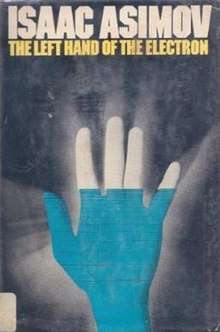The Left Hand of the Electron
The Left Hand of the Electron is a collection of seventeen nonfiction science essays by American writer and scientist Isaac Asimov, first published by Doubleday & Company in 1972. It was the ninth of a series of books collecting essays from The Magazine of Fantasy and Science Fiction. The title comes from the topic of the first section which deals with chirality of electroweak interactions and chirality of organic compounds and the possible connection between the two. Other essays in this book concern the effect of electron-spin direction on molecular structure e.g. the "Inverse Sugar" (similar to Inverted sugar syrup) in honey with philosophical reflections on the minority of left handedness in general.
 First edition | |
| Author | Isaac Asimov |
|---|---|
| Country | United States |
| Language | English |
| Series | Fantasy & Science Fiction essays |
| Subject | Science |
| Publisher | Doubleday |
Publication date | 1972 |
| Media type | Print (Hardback and Paperback) |
| Pages | 225 |
| ISBN | 0-385-04345-7 |
| Preceded by | The Stars in their Courses |
| Followed by | The Tragedy of the Moon |
Chapters
- A — The Problem of Left and Right
- 1 — Odds and Evens
- 2 — The Left Hand of the Electron
- 3 — Seeing Double
- 4 — The 3-D Molecule
- 5 — The Asymmetry of Life
- B — The Problem of Oceans
- 6 — The Thalassogens
- 7 — Hot Water
- 8 — Cold Water
- C — The Problem of Numbers and Lines
- 9 — Prime Quality
- 10 — Euclid's Fifth
- 11 — The Plane Truth
- D — The Problem of the Platypus
- 12 — Holes in the Head
- E — The Problem of History
- 13 — The Eureka Phenomenon
- 14 — Pompey and Circumstance
- 15 — Bill and I
- F — The Problem of Population
- 16 — Stop!
- 17 — ...But How?
gollark: You seriously believe in the Moon?
gollark: Wikipedia is omniscient and inevitable.
gollark: Or 128.
gollark: It's probably true that there's *a* maximum size limit, but it isn't obviously 150.
gollark: Wikipedia says:> A replication of Dunbar's analysis with a larger data set and updated comparative statistical methods has challenged Dunbar's number by revealing that the 95% confidence interval around the estimate of maximum human group size is much too large (4–520 and 2–336, respectively) to specify any cognitive limit.
External links
- Asimovonline.com
- Asimov, Isaac (1972). The Left Hand of the Electron (PDF). New York: Doubleday. ISBN 0-440-94717-0. Retrieved 2013-09-24.
This article is issued from Wikipedia. The text is licensed under Creative Commons - Attribution - Sharealike. Additional terms may apply for the media files.